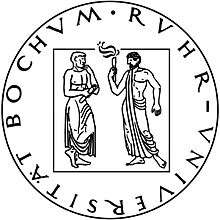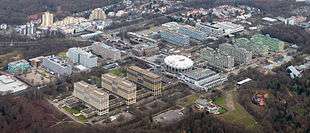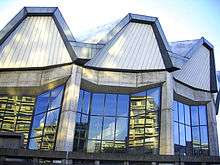Ruhr University Bochum
| Ruhr-Universität Bochum | |
 | |
| Motto | menschlich – weltoffen – leistungsstark (German)[1] |
|---|---|
Motto in English | People-centred – Cosmopolitan – High-performance [2] |
| Type | Public |
| Established | 1962 |
| Budget | € 539.1 million[3] |
| Chancellor | Christina Reinhardt[4] |
| Rector | Axel Schölmerich[4] |
Academic staff | 3,324[5] |
Administrative staff | 2,378[5] |
| Students | 42,425[5] |
| Undergraduates | 22,458[6] |
| Postgraduates | 9,814[6] |
| 3,619[6] | |
Other students | 7,223 (International Students)[7] |
| Location |
Bochum, North Rhine-Westphalia, Germany 51°26′38″N 7°15′42″E / 51.44389°N 7.26167°ECoordinates: 51°26′38″N 7°15′42″E / 51.44389°N 7.26167°E |
| Campus |
Urban/Suburban Campus area 4.5 sq.km[8] |
| Affiliations | UA Ruhr, DAAD, DFG, Utrecht Network, MAUI Network, AEN Network, NOHA Network |
| Website | www.ruhr-uni-bochum.de |
 | |
Ruhr-University Bochum (German: Ruhr-Universität Bochum, RUB), located on the southern hills of central Ruhr area Bochum, was founded in 1962 as the first new public university in Germany since World War II. Instruction began in 1965.
The Ruhr-University Bochum is one of the largest universities in Germany and part of the Deutsche Forschungsgemeinschaft, the most important German research funding organization.[9]
The RUB was very successful in the Excellence Initiative of the German Federal and State Governments (2007), a competition between Germany's most prestigious universities. It was one of the few institutions left competing for the title of an "elite university", but did not succeed in the last round of the competition. There are currently nine universities in Germany that hold this title.
The University of Bochum was one of the first universities in Germany to introduce international bachelor's and master's degrees, which replaced the traditional German Diplom and Magister. Except for a few special cases (for example in Law) these degrees are offered by all faculties of the Ruhr-University. Currently, the university offers a total of 184 different study programs from all academic fields represented at the university.[10]


Facilities
Unlike many older German universities, the buildings of Ruhr-University are all centralized on one campus, located south of Bochum city. The Faculty of Medicine includes several university clinics which are located at different centres in Bochum and the Ruhr area. A major facility for patient care is the University Hospital/Knappschaftskrankenhaus in the Langendreer part of Bochum. Internationally renowned experts in their respective fields are professors Wolff Schmiegel in oncology and Burkhard Dick in ophthalmology. The centralized university campus architecture is comprised almost exclusively of the 1960s architecture style referred to as Brutalism, consisting of 14 almost identical high-rise buildings. One striking feature of these buildings is that although their roofs are all at the same apparent height (sky level), the absolute heights of the buildings vary in accordance with their placement on the undulating landscape in which the university is located: the campus is at the edge of a green belt on high ground adjacent to the Ruhr valley.
The arrangement of the buildings and the (concrete) paths and bridges between them was originally meant to resemble a "harbour of knowledge", with the buildings symbolising vessels, by architect Helmut Hentrich.[11]
The campus undergoes heavy modernisation and extension efforts, including the construction and refurbishment of several buildings.[12] Some of the original 1960s buildings are to be rebuilt (instead of refurbished) due to PCB contamination.[13] The overall campus concept envisions a modern facility[14] and the placement of Bochum as a "knowledge city".[15]
Organization
Ruhr-University is financed and administered by the state of North Rhine-Westphalia. Currently, 42,718 students are enrolled, and the university employs around 5,600 staff (411 of which are professors),[16] making it one of the ten largest universities in Germany (as of 2014). Kurt Biedenkopf, who later became prime minister of the state of Saxony, was director of the university from 1967 to 1969.
The university is organized in twenty different faculties. These are:[17]
- Faculty of Protestant Theology
- Faculty of Catholic Theology
- Faculty of Philosophy, Education and Journalism
- Faculty of History (including the departments of History, Art History and Archaeological Sciences)
- Faculty of Philology
- Faculty of Law
- Faculty of Economics
- Faculty of Social Science
- Faculty of East Asian Studies
- Faculty of Sports Science
- Faculty of Psychology
- Faculty of Civil and Environmental Engineering
- Faculty of Mechanical Engineering
- Faculty of Electrical Engineering and Information Technology
- Faculty of Mathematics
- Faculty of Physics and Astronomy
- Faculty of Geosciences
- Faculty of Chemistry and Biochemistry
- Faculty of Biology and Biotechnology
- Faculty of Medicine
ECUE - European Culture and Economy
- Interdisciplinary institutions
- Interdisciplinary Centre for Advanced Materials Simulation (ICAMS)
- International Graduate School of Neuroscience[18]
Points of interest
- Botanischer Garten der Ruhr-Universität Bochum, a botanical garden with Chinese garden
- Hegel-Archiv, the archives of the German philosopher Georg Wilhelm Friedrich Hegel
- Medical historical collection of the Ruhr-University [19]
- Art collection, including Antiquity Museum of the Ruhr-University[20]
- Audimax and Klais-Organ of the Ruhr-University[21]
- Musisches Zentrum (Artistic center) [22]
See also
References
- ↑ Ruhr-Universität Bochum - Strategische PR und Markenbildung. "Porträt - Ruhr-Universität Bochum". Retrieved 21 July 2015.
- ↑ Ruhr-Universität Bochum - Strategische PR und Markenbildung. "Portrait - Ruhr-Universität Bochum". Retrieved 21 July 2015.
- ↑ "Accomplished". University of Bochum. Retrieved 21 July 2015.
- 1 2 "Members of the Rectorate". University of Bochum. Retrieved 2017-06-03.
- 1 2 3 "Humane". University of Bochum. Retrieved 2017-06-03.
- 1 2 3 "Statistics" (PDF). Retrieved 22 November 2016.
- ↑ "Statistics" (PDF). Retrieved 22 November 2016.
- ↑ Ruhr-Universität Bochum - Strategische PR und Markenbildung. "Facts and Figures - Ruhr-Universität Bochum". Retrieved 21 July 2015.
- ↑ Pressestelle Ruhr-Universität Bochum - Online-Redaktion. "Deutsche Forschungsgemeinschaft - Ruhr-Universität Bochum". Retrieved 21 July 2015.
- ↑ Ruhr-Universität Bochum - Strategische PR und Markenbildung. "High-performance - Facts & Figures - Ruhr-Universität Bochum". Retrieved 21 July 2015.
- ↑ Ruhr-Universität Bochum - Strategische PR und Markenbildung. "Architecture - Ruhr-Universität Bochum". Retrieved 21 July 2015.
- ↑ Ruhr-Universität Bochum - Strategische PR und Markenbildung. "Projects - Ruhr-Universität Bochum". Retrieved 21 July 2015.
- ↑ Arne Dessaul. "IA und IB werden neu gebaut". Retrieved 21 July 2015.
- ↑ Ruhr-Universität Bochum - Strategische PR und Markenbildung. "Concept - Ruhr-Universität Bochum". Retrieved 21 July 2015.
- ↑ Ruhr-Universität Bochum - Strategische PR und Markenbildung. "Master Plan - Ruhr-Universität Bochum". Retrieved 21 July 2015.
- ↑ Ruhr-Universität Bochum - Strategische PR und Markenbildung. "People-centered - Facts & Figures - Ruhr-Universität Bochum". Retrieved 21 July 2015.
- ↑ Ruhr-Universität Bochum - Strategische PR und Markenbildung. "Faculties - Ruhr-Universität Bochum". Retrieved 21 July 2015.
- ↑ "IGSN - Home". Retrieved 21 July 2015.
- ↑ Institut für Medizinische Ethik und Geschichte der Medizin. "Ruhr-Universität Bochum". Retrieved 21 July 2015.
- ↑ Ruhr-Universität Bochum - Kunstsammlungen Antike Kunst. "KUNSTSAMMLUNGEN DER RUHR UNIVERSITÄT BOCHUM · ANTIKE KUNST". Retrieved 21 July 2015.
- ↑ Maren Schuster. "Audimax". Retrieved 21 July 2015.
- ↑ Ruhr-Universität Bochum - Strategische PR und Markenbildung. "Ruhr-Universität Bochum". Retrieved 21 July 2015.